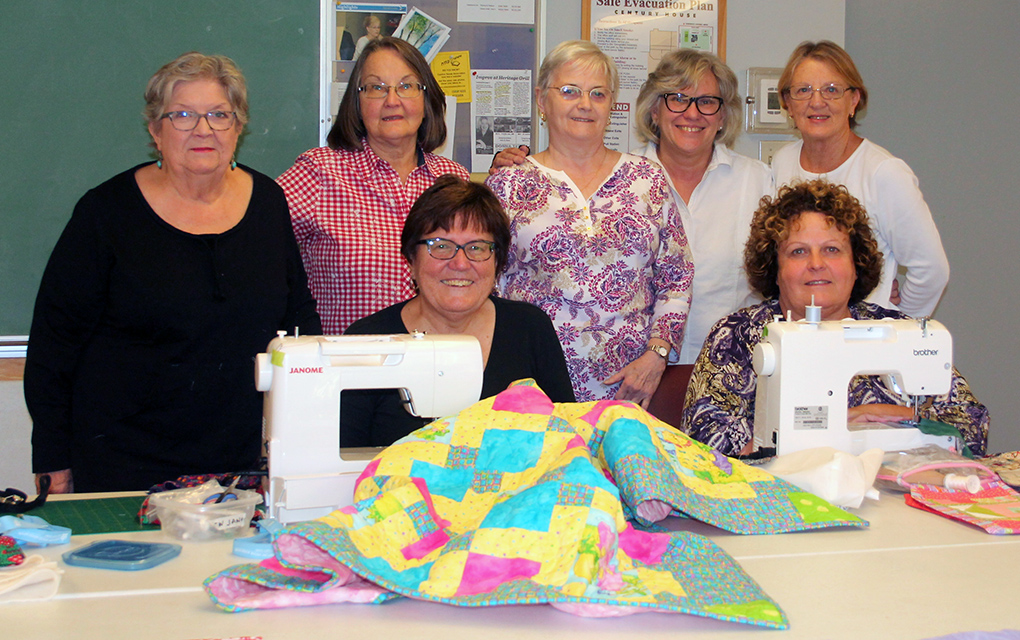The group is open to all members of Century House Association with a good knowledge of hand quilting and machine sewing experience; however, all levels of experience are welcome to attend our sessions.
Interested in quilting? Inquire at the front office or drop-in.
We get together and collaborate on new designs based on the fabric on hand. You can either cut fabric, hand stitch, machine sew or all of the above. We welcome fabric donations but we are subject to storage limitations and may not be able to accommodate your donation but we would still love to see what you have.
We make and sell baby quilts, runners, pot holders, place mats, lap quilts, and single/double quilts. Everyone’s welcome to stop by and see what handmade quilted items we have for sale.
All the proceeds of our quilt sales are donated to the Century House Association. Our quilts can be purchased at Century House Mondays and Thursdays between 9 am -11 am. We also sell our quilts at the Summer Bazaar and Winter Craft Sale.
Equipment & Materials: Provided by Activity Group
What is Quilting?
Quilting is a sewing method done to join two or more layers of material together to make a thicker padded material.
The process of quilting uses a needle and thread to join two or more layers of material to make a quilt. Typical quilting is done with three layers: the top fabric or quilt top, batting or insulating material and backing material. The quilter’s hand or sewing machine passes the needle and thread through all layers and then brings the needle back up. The process is repeated across the entire area where quilting is wanted. A rocking, straight or running stitch is commonly used and these stitches can be purely functional or decorative and elaborate. Quilting is done to create bed spreads, art quilt wall hangings, clothing, and a variety of textile products. Quilting can make a project thick, or with dense quilting, can raise one area so that another stands out.
The word “quilt” comes from the Latin culcita meaning a large stuffed sack, but it came into the English language from the French word cuilte. The origins of quilting remain unknown, but sewing techniques of piecing, applique, and quilting have been used for clothing and furnishings in diverse parts of the world for several millennia.
The earliest known quilted garment is depicted on the carved ivory figure of a Pharaoh of the Egyptian First Dynasty, about 3400 B.C.
Definitions
- Piecing: Sewing small pieces of cloth into patterns, called blocks, that are then sewn together to make a finished quilt top. These blocks may be sewn together, edge to edge, or separated by strips of cloth called sashing. Note: Whole cloth quilts typically are not pieced, but are made using a single piece of cloth for the quilt top.
- Layering: Placing the quilt top over the batting and the backing.
- Borders: Typically strips of fabric of various widths added to the perimeter of the pieced blocks to complete the quilt top. Note: borders may also be made up of simple or patterned blocks that are stitched together into a row, before being added to the quilt top.
- Binding: Long fabric strips cut on the bias that are attached to the borders of the quilt. Binding is typically machine sewn to the front side of the edge of the quilt, folded over twice, and hand sewn to the back side of the quilt.
- Quilting: Stitching through all three layers of the quilt (the quilt top, the batting, and the quilt back), typically in decorative patterns, which serves three purposes:
- To secure the layers to each other,
- To add to the beauty and design of the finished quilt, and
- To trap air within the quilted sections, making the quilt as a whole much warmer than its parts.


